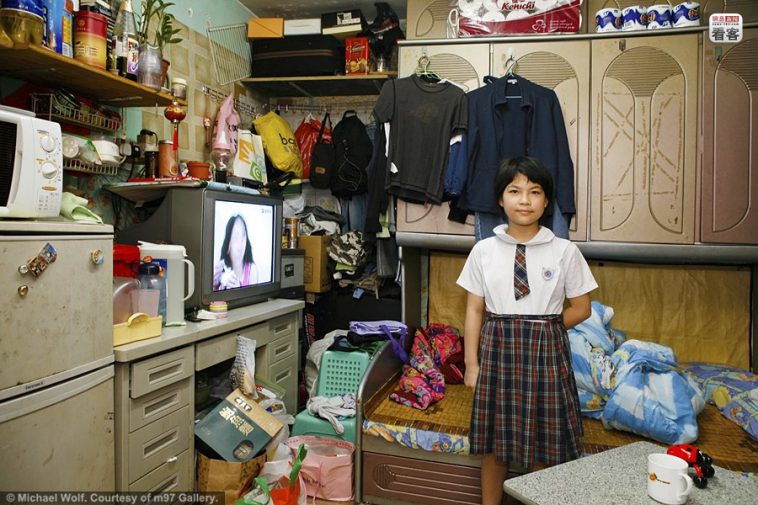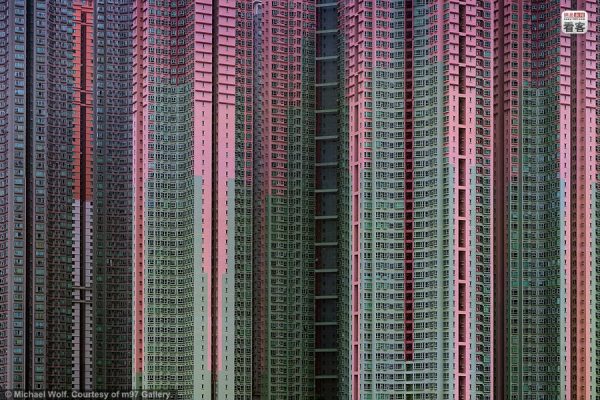From NetEase:
Hong Kong Ant Tribe
On Hong Kong’s 1,108 square kilometers of land live 7.07 million people. They have the world’s densest skyline while also
. German photographer Michael Wolf has completed photographing two collections “Architecture of Density” and “100×100” (100 households living in 100 square feet public apartments), in Hong Kong. The two pieces of work show the inside and outside of Hong Kong housing, and the other side behind the scenes. Photographer: Michael Wolf. Compiler: Fei Tian. Source: M97 Shanghai Contemporary Photography Gallery.
Architecture of Density
Because of historical, political, and geographical reasons, only 23.7% of Hong Kong’s land is developed. 76 square kilometers of land is developed for housing use, which occupies only 6.8% of the total land area.
Due to the high population density caused by limits on land development, 7.07 million people mainly live in residential high-rises. There are a total of 6588 high-rise buildings in all of Hong Kong, far surpassing New York’s 5818 buildings, becoming a veritable “skyscraper city”.
Michael Wolf’s “Architecture of Density” collection takes a look at these oppressive concrete “curtains”, painting a picture of abstract patterns that blot out the sky. [click to enlarge images]
Michael Wolf “Architecture of Density” #57 (2006)
Michael Wolf “Architecture of Density” #119 (2008)
Michael Wolf “Architecture of Density” #39 (2003)
Michael Wolf “Architecture of Density” #98 (2008)
Michael Wolf “Architecture of Density” #23 (2005)
Michael Wolf “Architecture of Density” #111 (2008)
Michael Wolf “Architecture of Density” #43 (2006)
Michael Wolf “Architecture of Density” #19 (2003)
Michael Wolf “Architecture of Density” #108 (2008)
Michael Wolf “Architecture of Density” #95 (2008)
100X100
Hong Kong’s average housing prices is 12.6x the median annual household income, ranking first/highest in the world. As of 2011, 47.7% of Hong Kong city residents live in public apartments (government subsidized housing) or residences (government rent-controlled housing) because they are unable to purchase private housing. It’s per capita residential space is 12.8 square meters.
Kowloon’s Shek Kip Mei Estates was Hong Kong’s first public housing development. On 1953 December 24th, the wooden Shek Kip Mei experienced a large fire, leaving 53,000 people homeless. The Hong Kong government directly intervened to provide housing, building new public housing in the original location for the disaster victims. Shek Kip Mei became a model, beginning Hong Kong’s era of public housing.
At the end of 2007 April, Michael Wolf learned that Shek Kip Mei Estates was to be demolished and rebuilt, and spent four days time going door to door to photograph every one of Shek Kip Mei’s 100 square feet (approximately 9.3 square meter) rooms, revealing these half-century old public housing units, and the stories of the 100 households that live there. 2007 May 1st, Shek Kip Mei’s residents began to move out, and the demolition began.
Michael Wolf “100×100” #20 (2006). Name: Lam Sam Mui. Age: 93. Time at this residence: 30 years. Former occupation: Peddler. What aspect of this public housing do you like: No comment.
Michael Wolf “100×100” #26 (2006). Name: So Sheung (right). Age: 94. Time at this residence: 25 years. Former occupation: Food delivery boy. What aspect of this public housing do you like: Low rent.
Michael Wolf “100×100” #18 (2006). Name: Choi Ting Shou (right). Age: 69. Time at this residence: 27 years. Former occupation: Security guard. What aspect of this public housing do you like: Friendly neighbors.
Michael Wolf “100×100” #4 (2006). Name: Liu Kam Chiu (left), Chung Fut (right) Age: 70 (left), 81 (right). Time at this residence: 17 years. Former occupation: Cleaning woman (left), peddler (right). What aspect of this public housing do you like: Convenient transportation, friendly neighbors, good ventilation.
Michael Wolf “100×100” #15 (2006). Name: Tham Ho. Age: 99. Time at this residence: 26 years. Former occupation: Cement plant worker. What aspect of this public housing do you like: Low rent, can chat with neighbors, neighbors take care of each other (one neighbor helps her buy food every day).
Michael Wolf “100×100” #37 (2006). Name: Yau Ka Yan. Age: 11. Time at this residence: 6 years. Occupation: Student. What aspect of this public housing do you like: Neighbors are good-natured and entertaining in conversation.
Michael Wolf “100×100” #92 (2006). Name: Ma Gui Woon. Age: 68. Time at this residence: 13 years. Former occupation: Clothing factory worker. What aspect of this public housing do you like: Everything.
Michael Wolf “100×100” #40 (2006). Name: Tam King (left). Age: 82. Time at this residence: 25 years. Former occupation: Metalwork factory worker. What aspect of this public housing do you like: Convenient transportation.
Michael Wolf “100×100” #69 (2006). Name: Tsang King Wah. Age: 11. Time at this residence: 7 years. Occupation: Student. What aspect of this public housing do you like: Convenient transportation.
Michael Wolf “100×100” #2 (2006). Name: Chung Ying. Age: 84. Time at this residence: 12 years. Occupation: Housewife. What aspect of this public housing do you like: Good environment, friendly neighbors.
Comments from NetEase:
潘马户邓小闲 [网易河南省焦作市网友]:
S what? At least none of them have to worry about being forcibly evicted and their homes demolished. The smiles on their faces are very natural!
dwylyfh [网易四川省成都市网友]: (responding to above)
SB, Hong Kong also has incidents of forced evictions/demolitions and roadside stalls being dismantled preventing people from making a living. Familiarize yourself with Hong Kong history. If you’re going to criticize, your criticisms still need to be convincing.
网易河北省保定市网友: (responding to above)
Hong Konger’s welfare is over a hundred times better than mainlanders, and that’s what attracts people. Just three things put mainlanders to shame: able to travel to over 100 countries without visas, the same strict food safety as Europe and America, the same education systems as Europe and America.
bbk2022 [网易广东省深圳市网友]:
Although Hong Kong looks a bit more run down than many mainland cities, I still feel Hong Kong is 100 years ahead of the mainland. Some things do not depend on the level of development of reinforced concrete cities, but rather society.
网易新西兰网友:
Living in bird cages yet their hearts fly.
春江渔舟 [网易广东省河源市网友]: (responding to above)
For them in their snail homes, as long as they work hard and struggle, they can purchase a good home.
For those in China, no matter how hard we struggle, we will always live in snail homes, unless your dad is Li Gang.
关评论得天下 [网易上海市网友]:
“…the burden of the world’s heaviest housing prices.” The mainland’s rabble laugh without words.
lxykkuu [网易广东省深圳市网友]:
Hong Kongers unable to afford homes is thanks to major contributions by Li Ka-shing.
海上钓鳌客 [网易山东省潍坊市网友]:
Are there forced demolitions there?
2484976 [网易江苏省苏州市网友]:
If Hong Kongers have something they’re unhappy, they go on the streets [and protest]… can those on the mainland…?
gewalamengtu [网易河北省邯郸市网友]:
So what gives Hong Kongers the qualification to look down on the mainland?
Hong Kong is just a heaven for the rich!
zjtzyl [网易浙江省台州市网友]:
How does it have the world’s heaviest housing price burden? I as a mainlander express serious disagreement. Please make public Hong Kong’s per capita income and housing prices.
wecanbetter [网易英国网友]:
There is poverty everywhere, but their ZF has accomplishments and works hard for change!
幸福的草泥马 [网易江苏省南通市网友]:
So why is there still so many people doing everything they can to go there?
男老师头套着女内裤打麻将 [网易广东省河源市网友]:
Hong Kongers look like they have money, but in reality an entire family is cramped inside a single room, with the son and daughter-in-law on the top bunk and two old people on the bottom bunk. When the son and daughter-in-law want to fuck, they don’t dare fuck too hard.
你说点真话能死啊 [网易辽宁省大连市网友]:
Hong Kong has no land that can be used and no room that can be lived in so the housing prices are relatively high. In the mainland, there are empty houses everywhere and housing prices are still astronomical and won’t come down, why is this?
dongxf [网易广东省深圳市网友]:
Asia’s richest man is Li Ka-shing, and a bunch of real estate developers, such as Walter Kwok and family…
The money of Hong Kong’s ordinary common people has all been taken away by the real estate developers. A lifetime of hard work and actually its all working for Li Ka-shing and them.
Mainland China’s real estate developers watch them with envy, working hard towards the same direction.
dali668 [网易辽宁省鞍山市网友]:
An objective look at the housing conditions of Hong Kong’s disadvantaged social groups. I wonder if they feel blessed/happy.
网易香港网友:
High density residences at the same time protects the green outskirts. 5 minutes out the door and you can go hiking and enjoy nature, can you do that on the mainland? Go look at Google satellite maps and you’ll see.
zengfei37 [网易广东省佛山市网友]:
Why don’t they have family planning [in Hong Kong, to control the population]!!!
pahdl [网易浙江省金华市网友]:
Liberate Hong Kong, let our Hong Kong compatriots enjoy the superiority of a socialist system!
What was the smallest living conditions you have experienced?























140 Comments
Leave a Reply10 Pings & Trackbacks
Pingback:Exactamente ¿Qué tan apretados están en Hong Kong?: Muy | Curiosidades desde el punto de vista de un posible demente
Pingback:Images Of This Skyscraper City Will Blow Your Friggin’ Mind | Kotaku Australia
Pingback:Hong Kong’s High Density and Cramped Living Conditions | BALTYRA
Pingback:I heart HK: Density | little BIG design lab
Pingback:Hong Kong: Living in High-rises · Global Voices
Pingback:Hongkong: Ilyen az élet a toronyházakban! · Global Voices Magyarul
Pingback:Χονγκ Κονγκ: Η ζωή σε ουρανοξύστες · Global Voices στα Ελληνικά
Pingback:Hong Kong vs Singapore: Public Housing « Singapore Armchair Critic
Pingback:Forever cramped in Hong Kong « Hans K.C.'s Journal
Pingback:【東南亞來訊】Hong Kong VS Singapore (2): Public Housing - The Glocal | The Glocal